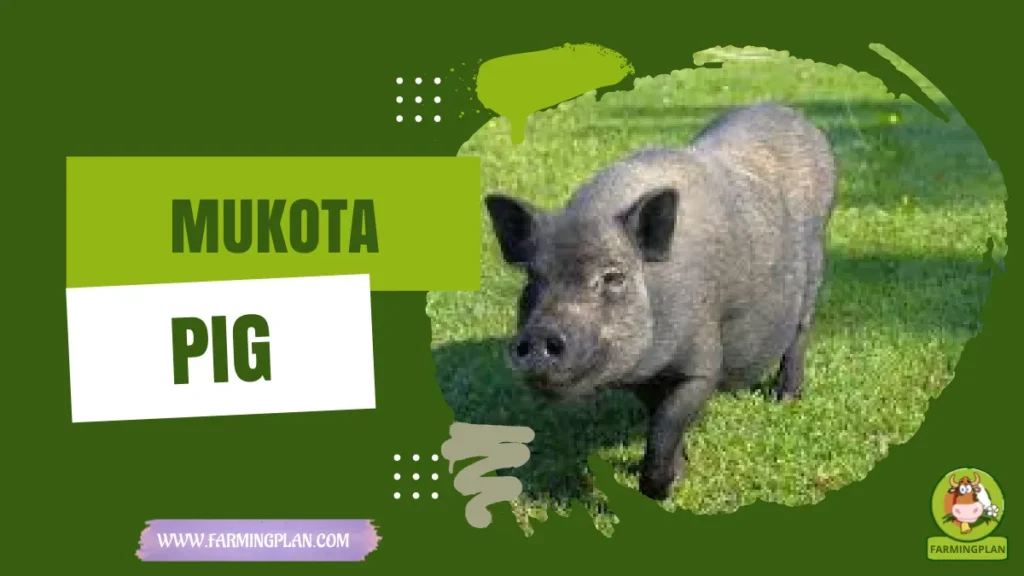Dairy goat breeds are becoming a popular choice for families, farmers, and homesteaders looking for a reliable and creamy milk source. These friendly and productive animals offer a wide range of benefits, from high butterfat content to sweet personalities that make them easy to manage. Whether you want milk for drinking, cheese-making, or to build a small dairy herd, choosing the right breed of dairy goat is the first step. With so many types like Alpine goats, Nubian goats, Nigerian Dwarves, and Saanen goats, it’s easy to find a goat that fits your needs, climate, and lifestyle. Let’s explore the best dairy goat breeds, their special traits, and how to care for them with confidence.
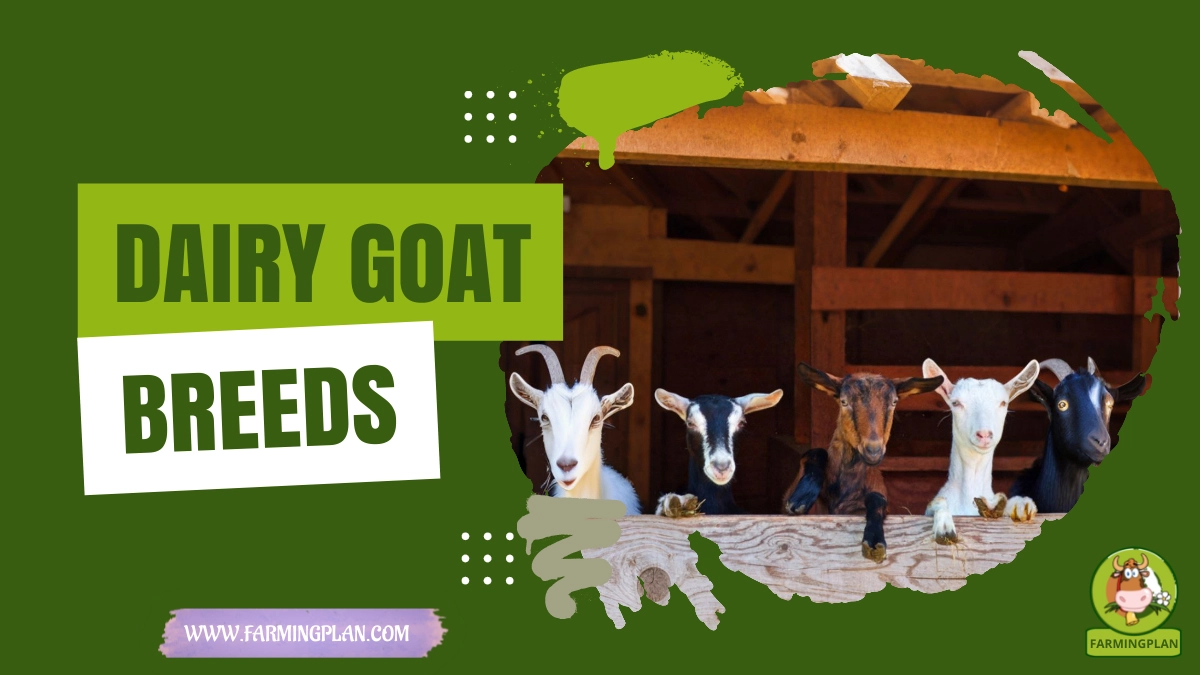
History & Origin
Dairy goat breeds, with their rich history spanning thousands of years, have been a part of human civilization since its early days. Goats were among the first animals humans raised for milk, long before the widespread popularity of dairy cows. In Europe, Asia, and Africa, goats were a reliable source of milk and soft cheese, thanks to their small size, hardy nature, and ability to thrive on a variety of forage.
Many modern breeds, like the Saanen goat and Toggenburg goat, came from Swiss breeds developed in the mountains of Switzerland. These goats were known for their strong milk production and ability to thrive in rough terrain. Over time, they were brought to North America, where farmers worked with groups like the American Dairy Goat Association (ADGA) to create and register purebred goats. Breeds such as the LaMancha goat, developed in the U.S., and the popular Nubian goat with its Middle Eastern roots show how dairy goats come from all over the world.
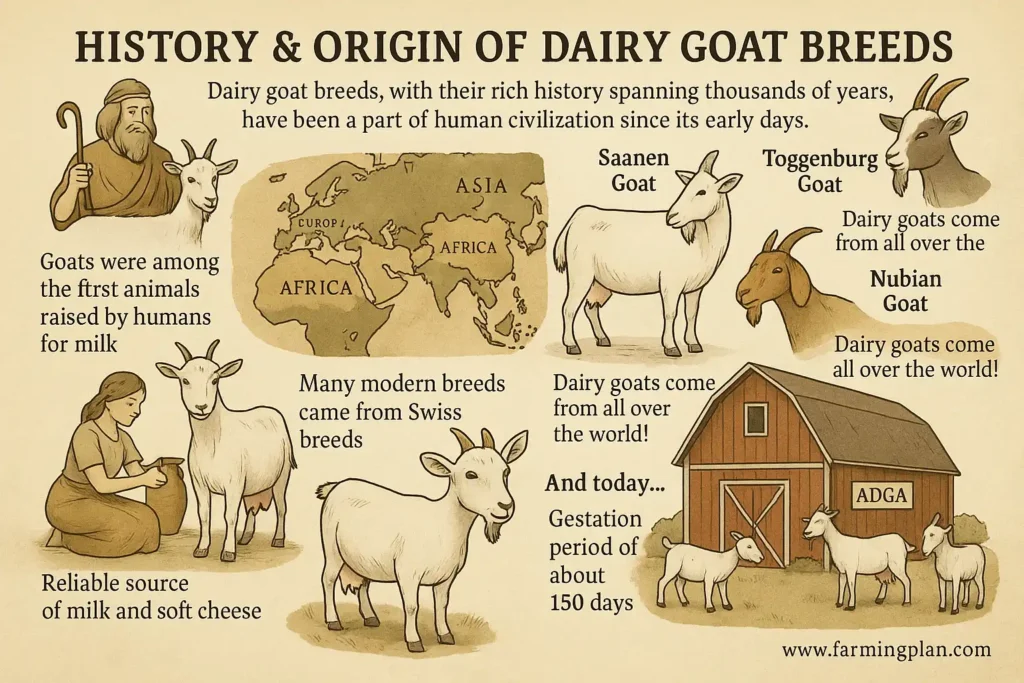
Today, these goats continue to play an important role in the dairy industry, offering a variety of choices for milk lovers, hobby farmers, and large commercial dairies alike. If you’re interested in expanding your herd, it’s important to understand the breeding process for dairy goats, which typically involves a gestation period of about 150 days.
Reads More: Amazing American Giant Runt Pigeon: The Ultimate Utility Bird
Characteristics of Dairy Goat Breeds
Each dairy goat breed has its own special look, size, and milk traits. Some goats are larger and produce more milk per day. Others are smaller but give richer milk with higher butterfat content and protein. Alpine goats are known for their tall, strong bodies and alert appearance. They come in a wide range of colors, from light fawn to black, often with beautiful color patterns. Their milk has a mild taste and good milk fat content, making it a favorite in dairy goat herds.
The LaMancha goat stands out with its tiny “gopher ears.” It’s a medium-sized goat with a sweet personality and high milk output. Saanen goats, known as the “Holsteins” of goats, are larger goats with a calm nature and white coats. They’re known for producing large quantities of milk, often with low butterfat.
If you want goat milk with rich flavor, the Nubian goat breed is a top pick. These goats have long, floppy ears, come in many colors, and give milk with impressive butterfat percentage. Nigerian dwarf goats are miniature goats that pack a punch when it comes to butterfat and protein content, even though they’re small in size.
One of the most appealing aspects of dairy goat breeds is their adaptability. These animals are not only versatile in terms of their uses but also in their ability to thrive in a variety of climates. Whether you’re looking for a dual-purpose goat or a creamy milk producer, there’s a breed of dairy goat that can match your goals and fit into your lifestyle.
Nature & Temperament
One of the most endearing qualities of dairy goat breeds is their friendly and social nature. These animals thrive on human interaction and enjoy the company of their herd mates, making them a perfect fit for families, homesteads, and small farms. Their sociable behavior can bring a sense of companionship and joy to your daily life. Nubian goats are playful and full of personality. They are curious, talkative, and enjoy attention. Some owners say they act more like pets than livestock! Their lively spirit makes them a favorite dairy breed, especially for those who enjoy bonding with their animals.
LaMancha dairy goats, with their gentle and calm nature, are known for getting along well with both people and animals. They are quiet, easy to handle, and adapt well to different management systems. These goats are a great choice for beginners. Alpine goats are alert and active. They have a strong work ethic and do well in cooler climates. Their calm but confident behavior makes them a smart pick for anyone starting a productive goat herd.
If you’re short on space, Nigerian Dwarves are a sweet and calm option. These miniature goats are small in size but full of charm. They are easy to train, love attention, and do well in small yards or barns. All breeds of dairy goats enjoy routine and gentle care. When treated kindly, they become affectionate and loyal. Their easygoing nature, along with their ability to adapt, makes them a smart and attractive choice for both new and experienced goat keepers.
Tip: “Goats that are handled with care from a young age grow up to be calm, social, and easy to manage.”
Food & Diet
Feeding your dairy goat breeds the right way helps boost milk production and keeps them healthy. However, it’s also essential to ensure their overall health through regular check-ups with a veterinarian. Goats need a balanced diet that supports their energy, protein, and butterfat needs. The main part of their diet should be high-quality hay or pasture. Goats love to browse on a variety of forage like weeds, shrubs, and grasses. Make sure the forage is clean and mold-free to keep their stomachs in good condition.
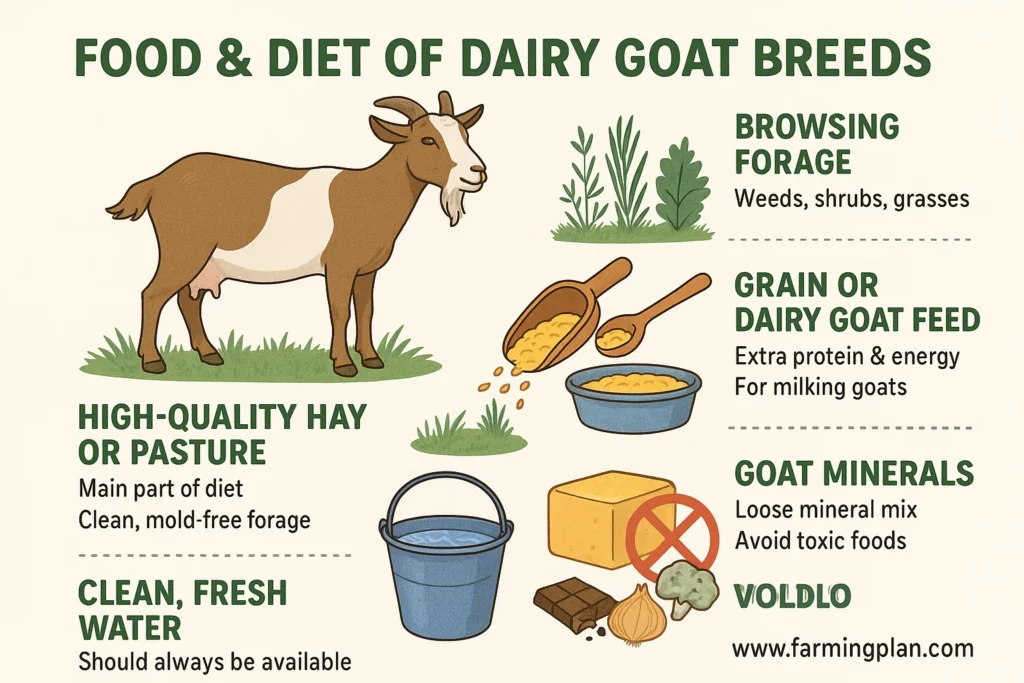
For milking goats, you’ll also need to offer grain or dairy goat feed. This adds protein content and energy, especially during lactation when milk demands are high. Be careful not to overfeed, as too much grain can upset their stomach. Clean, fresh water should always be available. Goats drink a lot, especially larger breeds like the Saanen goat, because goat milk is mostly water. A lack of water can quickly lower their milk output.
Goats also need minerals. Use a loose goat-specific mineral mix with important nutrients like calcium and copper. Avoid giving them minerals meant for sheep, since those don’t meet goat needs. Do not feed goats food like onions, chocolate, or anything moldy. These can make them sick. Always check the condition of their feed and avoid sudden changes in diet. A well-fed goat gives more pounds of milk and has better body condition scoring throughout her 305-day lactation cycle.
Usage & Purpose
Dairy goat breeds are raised mainly for one thing—milk production. Their milk is creamy, rich, and easy to digest. Many people prefer goat milk over cow milk, especially for making cheese, cream, and even ice cream. Goat milk has a high butterfat content, which makes it perfect for soft cheeses like chèvre, as well as other common cheeses. Some goats, like Nubian goats and Nigerian dwarf goats, are known for giving milk with an impressive butterfat content. In commercial dairies and small homesteads, people use dairy goat breeds to create a steady supply of fluid milk. Others use the milk to make homemade soaps, lotions, and yogurt.
These goats also serve other purposes. Some, like Nubians, are considered dual-purpose goats because they produce both milk and quality meat. On small farms, goats can help clear brush and weeds thanks to their natural browsing habits. Many families keep goats as pets. Miniature goats like the Nigerian Dwarves are friendly, easy to handle, and perfect for kids to raise. They’re not just useful—they’re fun too!
In shows and competitions, goats like the Alpine and Toggenburg breeds are judged on their appearance, milk quality, and overall health. Groups like the American Dairy Goat Association (ADGA) help set the breed standard and track purebred dairy goats. No matter your goal—milk, show, hobby, or business—there’s a breed of dairy goat that fits your needs.
“Consistent Care And A Friendly Goat Make The Creamiest Milk – Happy Goats, Happy Farmers!”
Special Features of Dairy Goat Breeds
Each of the main dairy goat breeds has unique traits that make it stand out. These special features often help goat owners choose the right breed for their farms or homesteads. Let’s start with the LaMancha goat. It’s easy to spot thanks to its tiny gopher ears. No other dairy breed has this look! But LaManchas are more than their ears—they’re calm, friendly, and produce plenty of milk with good butterfat percentage.
Alpine goats are famous for their variety of colors and strong milk production. Their coats can include shades like light fawn, white, black, or a combination of colors. They also have a striking appearance with alert eyes and upright ears. Nubian goat breeds bring two major features: long floppy ears and super creamy milk. Their milk has one of the highest butterfat contents of all breeds of goats for milk. Nubians also have bold, fun personalities that many people love.
Saanen goats are pure white and often the top pick for large-scale dairy goat farming. They are heavy producers, with great feed to milk efficiency. They perform well in cooler climates and have a calm nature. For a small but mighty goat, check out Nigerian dwarf goats. These miniature goats come in many colors and have a high protein and butterfat content in their milk. That makes them a creamy milk source in a compact size!
Some goats even have recessive color genes, leading to rare and beautiful color combinations. This adds aesthetic appeal and makes them fun to show or breed. These adaptable animals thrive in a variety of climates and suit many management practices. Whether it’s their look, milk, or behavior, there’s always something special about each breed of dairy goat.
Reads More: Lahore Pigeon Charm: A Colorful Companion For All
Health Issues & Prevention
Keeping your dairy goat breeds healthy means watching for common health problems and acting fast. Good health helps goats produce quality goat milk and stay active. One common issue is internal parasites (worms). They can make goats weak and reduce milk production. Regular body condition scoring helps spot when a goat loses weight or looks unwell. Using a vet-recommended dewormer and rotating pastures keeps worms under control.
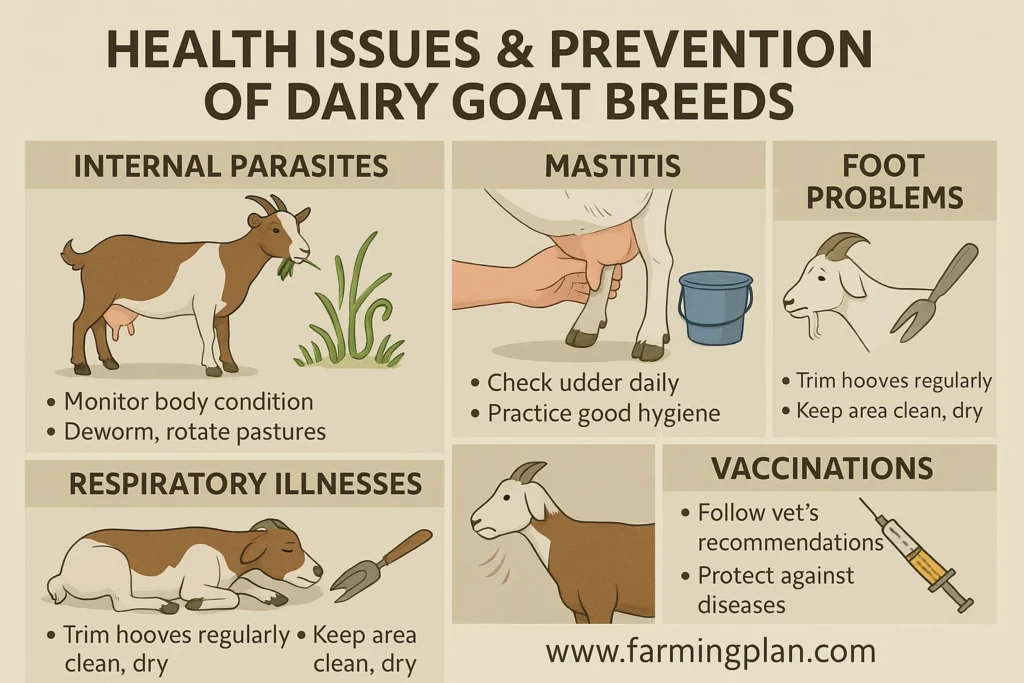
Mastitis is an infection of the udder and can hurt milk quality. Check your goats’ udders every day during milking. Look for swelling, heat, or unusual lumps. Clean milking equipment and practice good hygiene to prevent infections. Foot problems like hoof rot or overgrown hooves cause pain and make goats limp. Trim hooves regularly and keep their living area clean and dry. Goats can catch respiratory illnesses too. Signs include coughing, nasal discharge, and loss of appetite. Keep your goats dry and well-ventilated, especially in cold or damp weather.
Vaccinations protect against diseases like CAE (Caprine Arthritis Encephalitis) and CL (Caseous Lymphadenitis). Work with your vet to follow a vaccination schedule that fits your herd. Good nutrition, clean water, and a calm environment boost your goats’ natural defenses. Watch them closely, and early treatment keeps your herd strong and productive.
Step-by-Step Farming & Care Guide for Dairy Goat Breeds
Raising dairy goat breeds is rewarding when you follow a simple, step-by-step plan. Here’s how to get started and keep your goats happy and productive.
Step 1: Prepare the Housing
Choose a clean, dry shelter with good ventilation. Goats need at least 15-20 square feet per animal. Make sure the space protects them from extreme weather and predators.
Step 2: Choose Your Breed
Pick a breed of dairy goat that fits your climate and goals. For creamy milk in hot climates, Nubian goats work well. For cooler areas and high volume, try Saanen goats.
Step 3: Provide Balanced Feed
Offer quality hay or pasture daily. Add dairy-specific grain during lactation to boost milk production. Always provide fresh, clean water and mineral supplements made for goats.
Step 4: Set Up Milking Routine
Milk your goats twice a day at regular times—clean udders before milking to avoid infections like mastitis. Use clean equipment and keep milking areas sanitary.
Step 5: Monitor Health
Check your goats daily for signs of illness, such as changes in appetite, behavior, or appearance. Regularly trim hooves and schedule vaccinations and parasite control with your vet.
Step 6: Socialize and Handle Gently
Spend time with your goats to build trust. Friendly goats are easier to manage and often produce more milk.
Step 7: Manage Breeding and Kids
Plan breeding to keep a steady milk supply. Provide special care for pregnant does and newborn kids, including proper nutrition and clean living spaces. Following these steps will help you create a thriving dairy goat farming or pet care routine that fits your lifestyle and goals.
Expert Tips & Best Practices for Dairy Goat Breeds
To get the best results from your dairy goat breeds, keep these expert tips in mind:
- Start with healthy, purebred goats. Choosing goats registered with the American Dairy Goat Association (ADGA) ensures you get good genetics and reliable milk production.
- Maintain consistent feeding and milking schedules. Goats thrive on routine, and consistency helps improve milk yield and quality.
- Use proper body condition scoring. This simple method lets you track your goats’ health and adjust feed to keep them in optimal shape during their 220- to 240-day lactation period.
- Rotate pastures regularly. This practice helps reduce parasites and provides fresh forage, which supports better nutrition and milk quality.
- Keep detailed records. Track milk production, breeding, health treatments, and vaccinations. This information helps you make informed management decisions.
- Provide enrichment and social time. Goats are social animals. Giving them space to interact reduces stress and supports a calm, friendly herd.
- Train yourself on breed standards. Knowing the unique traits of breeds like Alpine, Toggenburg, or Saanen goats helps you identify the best animals for your herd.
- Be patient and gentle. Goats respond well to kind handling, which encourages an upbeat personality and easier management.
Tip: “Consistent care and attention to your goats’ needs lead to healthier animals and better milk production.”
Where to Buy Dairy Goat Breeds
Finding the right place to buy your dairy goat breeds is key to building a strong, healthy herd. Here are some tips to help you find quality goats:
- Local breeders and farms often offer healthy, well-raised goats. Look for breeders registered with the American Dairy Goat Association (ADGA) to ensure purebred animals.
- Search online marketplaces for specific breeds, like Nigerian dairy goats for sale, Nubian goat sale near me, or Alpine goat for sale. Be sure to ask about health records and lineage.
- Visit livestock auctions or agricultural fairs where you can see goats in person and talk to owners.
- Some farms specialize in miniature breeds like Nigerian dwarfs for sale or blue cactus dairy goat breeds, which are great for smaller spaces or beginners.
- Join local or online goat-keeping groups to get recommendations on trusted sellers and share advice.
- Check with nearby dairy goat herds or goat farming associations for referrals.
Before buying, always inspect the goats for signs of good health, ask about vaccination history, and verify the breeder’s reputation.
FAQs
What are the best dairy goat breeds for milk production?
The best dairy goat breeds include Saanen, Alpine, Nubian, LaMancha, and Toggenburg. Each offers high milk yield with varying butterfat content, making them popular for dairy farming and homesteads.
How much milk does a dairy goat produce daily?
On average, dairy goats produce about 6 to 12 pounds (3 to 5 liters) of milk per day during peak lactation, depending on the breed and management practices.
Are Nigerian dwarf goats good for milk?
Yes, Nigerian dwarf goats produce milk with high butterfat and protein, ideal for making cheese and cream. Their smaller size makes them perfect for small farms or hobbyists.
What do dairy goats eat?
Dairy goats need a diet of quality hay or pasture, supplemented with grains during lactation. Clean water and mineral supplements designed for goats are essential for healthy milk production.
Where can I buy purebred dairy goats?
You can buy purebred dairy goats from reputable local breeders, agricultural fairs, and online marketplaces. Always check for ADGA registration and health records before purchasing.
Conclusion
Dairy goat breeds offer a wonderful mix of high milk production, rich butterfat content, and friendly personalities suited for farms and homesteads. Popular breeds like Alpine, Nubian, and Saanen adapt well to different climates and management styles. Whether you want goats for creamy milk, cheese making, or a pet-friendly herd, understanding their traits, care needs, and where to find them sets you up for success. With proper feeding, health care, and daily attention, dairy goats can provide a rewarding, sustainable source of quality goat milk for years.

